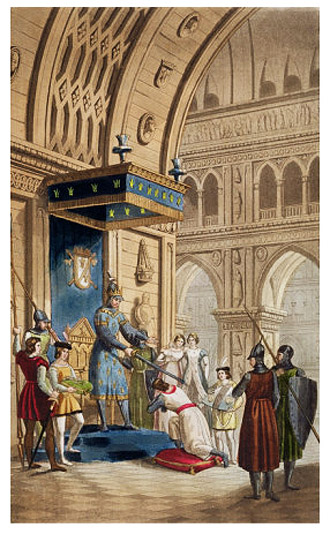
This list of 10 most well known knights in the history of the medieval Knights Templar includes heroes, saints, traitors and even one pirate. The order is largely chronological. If you want to read fascinating stories related to these (an many other) individuals, you definitely should check out Legends of the Knights Templar.
Hugues de Payens – the first Grand Master of the Knights Templar. Served from c.1119 to 1136. Hugues was related to the Counts of Champagne. His family and feudal ties assured that the Knights Templar gained support of upper nobility and influential clergymen such as Bernard de Clairvaux. After the incorporation of the Knights Templar, Hugues de Payns personally traveled to the West seeking support for the newly formed Order.
Godfroi de St Omer – considered one of the two principal founders of the Knights Templar, along with Hugues de Payens. Most likely descendant of the St Omer family in Picardy.
Gerard de Ridefort – the tenth Grand Master of the Knights Templar (1185 – 1189). Most likely of Flemish roots, Gerard de Ridefort was known for his impetuous temper. Although he clearly possessed personal bravery, his rash decisions led to one of the worst defeats of the Christian forces in Outremer in the battle of Hattin. De Ridefort himself was captured, but unlike the other Templars he was held for ransom and later released. He died during the siege of Acre in 1189.
Guillaume de Beaujeau – the 20th Grand Master of the Knights Templar (1273-1291). Guillaume bravely fought and died during the siege of Acre in 1291. Legend has it, de Beaujeau threw his sword down and proceeded to walk away from the front lines. When questioned as to why he was fleeing, the Grand Master replied, “I am not fleeing. I am dead.” De Beaujeau’s death sealed the fate of the city. Acre was lost to the Crusaders forever.
Roger de Flor (1266-1306) – probably the most famous Templar who was a sergeant-brother, not a knight. Roger de Flor (also known by his original German name of Rutger von Blume) was a captain in the Templar fleet. After he got banished from the Order on charges of extorting money from passengers during the siege of Acre in 1291, Roger sought employment around the Mediterranean, eventually becoming a pirate. De Flor’s assassination was ordered by the Byzantine Emperor Michael IX Palaeologus.
Geoffroi de Charney (1252-18 March 1314) – At the height of his career de Charney held an important position of the Preceptor of Normandy. He was burned at the stake in Paris alongside Jacques de Molay, as both proclaimed the Order’s innocence. It is presumed that de Charney family remained in possession of the most cherished Templar relic which was later revealed to the public by a French knight named Geoffroi de Charny in the 1350s. Today this relic is known as the Shroud of Turin.
Jacques de Molay (c. 1244 – 18 March 1314) – the 22nd and last Grand Master of the Knights Templar. De Molay tried to revitalize the Order after the loss of Outremer. He rejected existing plans to merge the Templars and the Hospitallers into a single organization. During the trials, de Molay initially agreed to the charges against the Knights Templar, but later recanted his confessions. Jacques de Molay was burned at the stake in Paris in 1314.
Pierre de Bologna (1270-1310?) – unlike most Templars, de Bologna was well educated. It is possible that he received legal training in Bologna, Italy. An ordained priest, he participated in the most notable legal attempt to clear the Knights Templar of any charges. De Bologna argued that torture could not have produced credible evidence. These defense efforts were met with fierce retribution: the knights who went back on their testimonies were burnt at the stake as relapsed heretics.
Esquin de Floyran (d. 1316) – believed to be the first person to voice his accusations against the Knights Templar, leading to their persecution by King Philip the Fair of France. There is evidence that de Floyran, a renegade Templar, held a grudge against the Order, having been punished by the Grand Master.
Hugues de Pairaud (b. 1244) – Jacques de Molay’s deputy and Visitor of the Temple in France and Poitou. Unlike de Molay and de Charney, Hugues never recanted his testimonies and most likely remained incarcerated for the rest of his life. Hugues de Pairaud was still alive in 1321, when he was interrogated regarding the whereabouts of the Templar treasures.
You may also enjoy reading this:
History of the Knights Templar at a glance


6 comments… add one
cooool!
Dear A.A. Grishin,
Please may I make a suggestion that you make this the most famous 12 Templars and add on the following two? Gerard de Villiers and Johannes Marcus (French: Jean-Marc) Larmenius.
More about these Two:
Gerard de Villiers- Preceptor of France, highest ranked officer to be documented as having escaped the persecution of King Philip IV.
——————–
A key figure in this list is certainly Gerard de Villiers, master of France. He is often given the second rank in the hierarchy of French Templars, but regarding the fact that the Visitor Hugues de Pairaud was already in his declining years, Gerard de Villiers played perhaps even the main role. We know nothing about his origin, but he is often confused with another Gerard de Villiers, preceptor of a mighty Wallon commandery in Villiers-le-Temple, who died in 1273. The Villiers family was one of the noblest and not only in the Temple Order, Jean de Villiers was for example the Grand Master of the Hospital, who heroically fought while defending Acre in 1291. The historians know also the name of Pierre de Villiers, who held the high post of Templar commander in Aquitaine in 1292-1300. Besides, from the trial’s records we know of a Templar priest Guillaume de Villiers, who refused to defend the Order in front of the papal commission referring to his poverty and old age, and Bernard de Villiers, preceptor of the commandery in Sent-Paul-la-Roche, who testified against the Temple in 1309 and 1311. We don’t know exactly that kind of kinship existed between all these people, but apparently they were relatives.
We don’t know the time and age when Gerard de Villiers joined the Order but probably it happened not later than 1295. In 1297 he became lieutenant of the Master of France, that was Hugues de Pairaud then, who was also the Visitor at the same time. In 1300 Villiers became the Master of France and started a very prolific administrative activity, which results we see in many receptions and regional chambers organized by him. With the same energy he took up the economic issues, for except being a Master of France he also remained preceptor of the largest Order’s bailliages. This explains the fact that sometimes in the trial he is mentioned as, for example, the head of such bailliages as Brie or Mont-de-Soissons. But right before the trial some curious events took place. The last mention of the Master Gerard de Villiers dates from the February 1307, and already in June, just a couple of months before the arrests, the documents signed by the Master of France bear the name of Hugues de Pairaud[24]. Later on, after the arrests, the Templars held in Paris forwarded a petition to be allowed to meet the highest Order’s officials: the Grand Master Jacques de Molay and the Master of France Hugues de Pairaud! But what has happened to Villiers? If he was displaced, then what for? And if he was already dead by that time, why is it stated that he fled?
Johannes Marcus Larmenius
———————————-
That second in charge under De Molay was the Palestinian-born Christian and Knight Templar Seneschal, Johannes Marcus (French: Jean-Marc) Larmenius. At the time of De Molay’s death, Larmenius was fairly aged himself, and was holding the last of the remaining Templar Order together on Cyprus. To the historic figure of Johannes Marcus Larmenius, is added the highly controversial story of the “Larmenius Charter,” which can be read about here: http://www.theknightstemplar.org/larmenius/
Wonderful list and great suggestions for the two to add Rev Tim!
What do you know about the Knights Templar with the sur name “Cupoli” ?
and Gualdim Pais, not in list ???
Found out recently that my name spelled Francis with the C – I – S was very popular and desired by many but we were associated with the KNIGHTS TEMPLARS. I want to learn all I can about them.